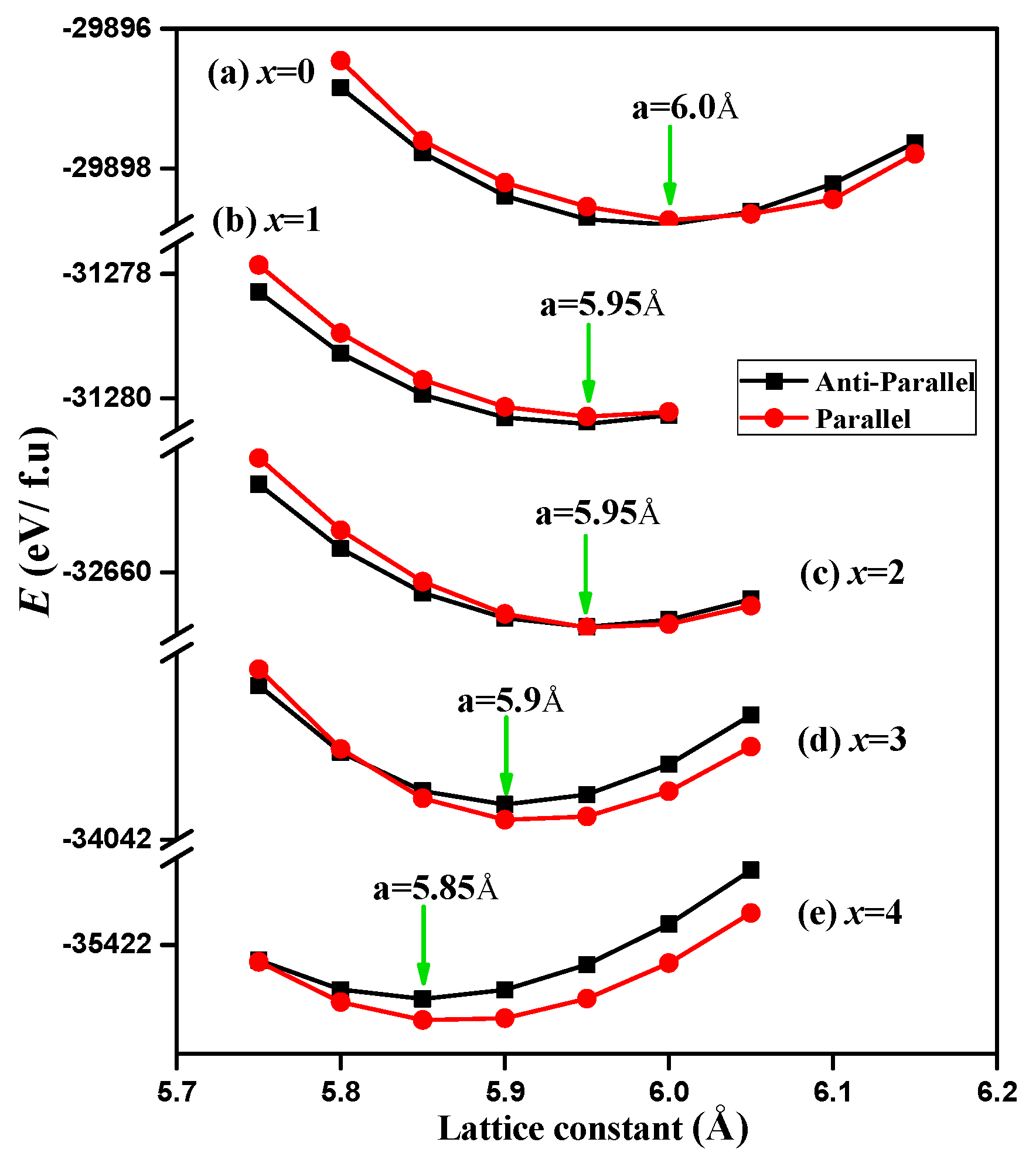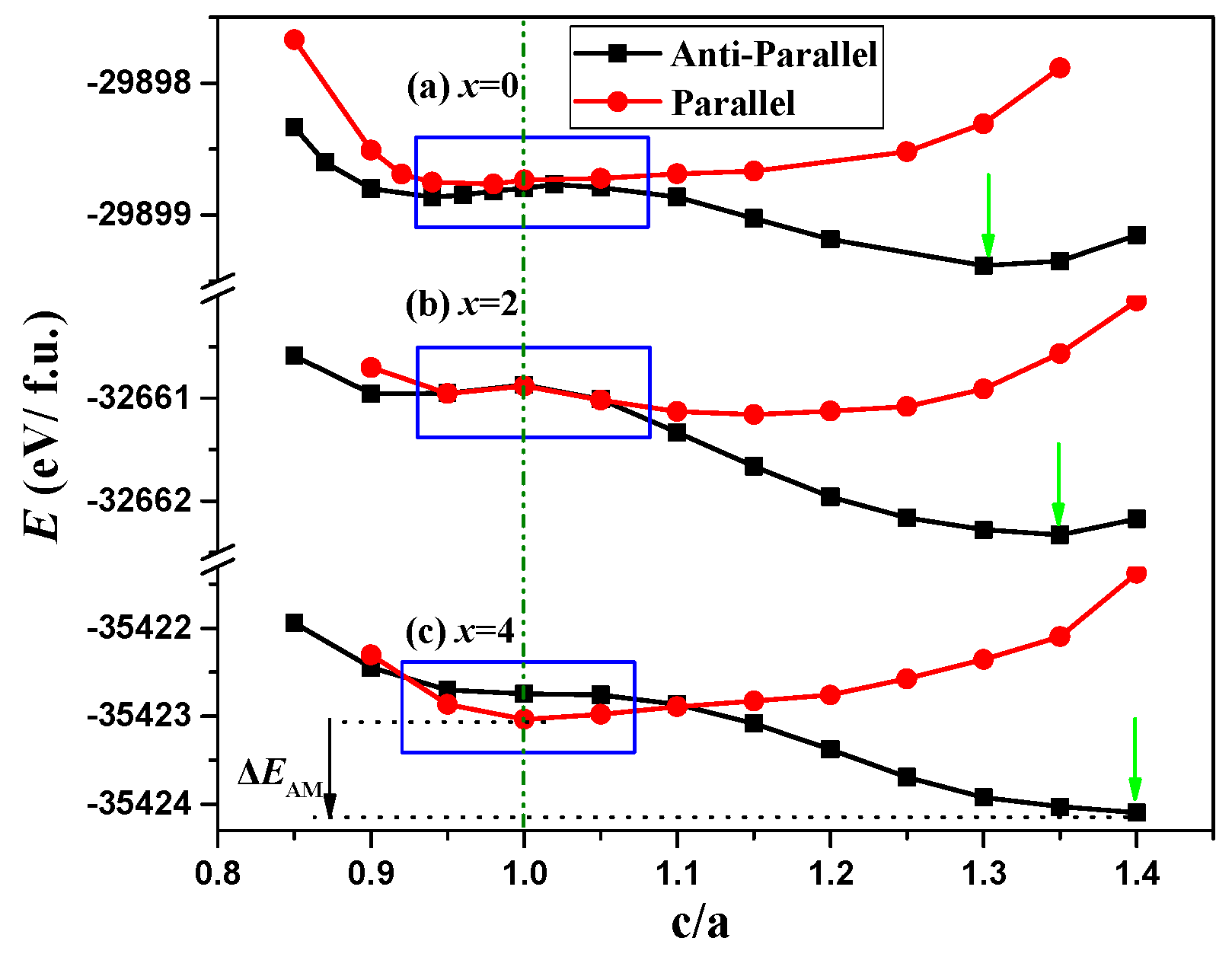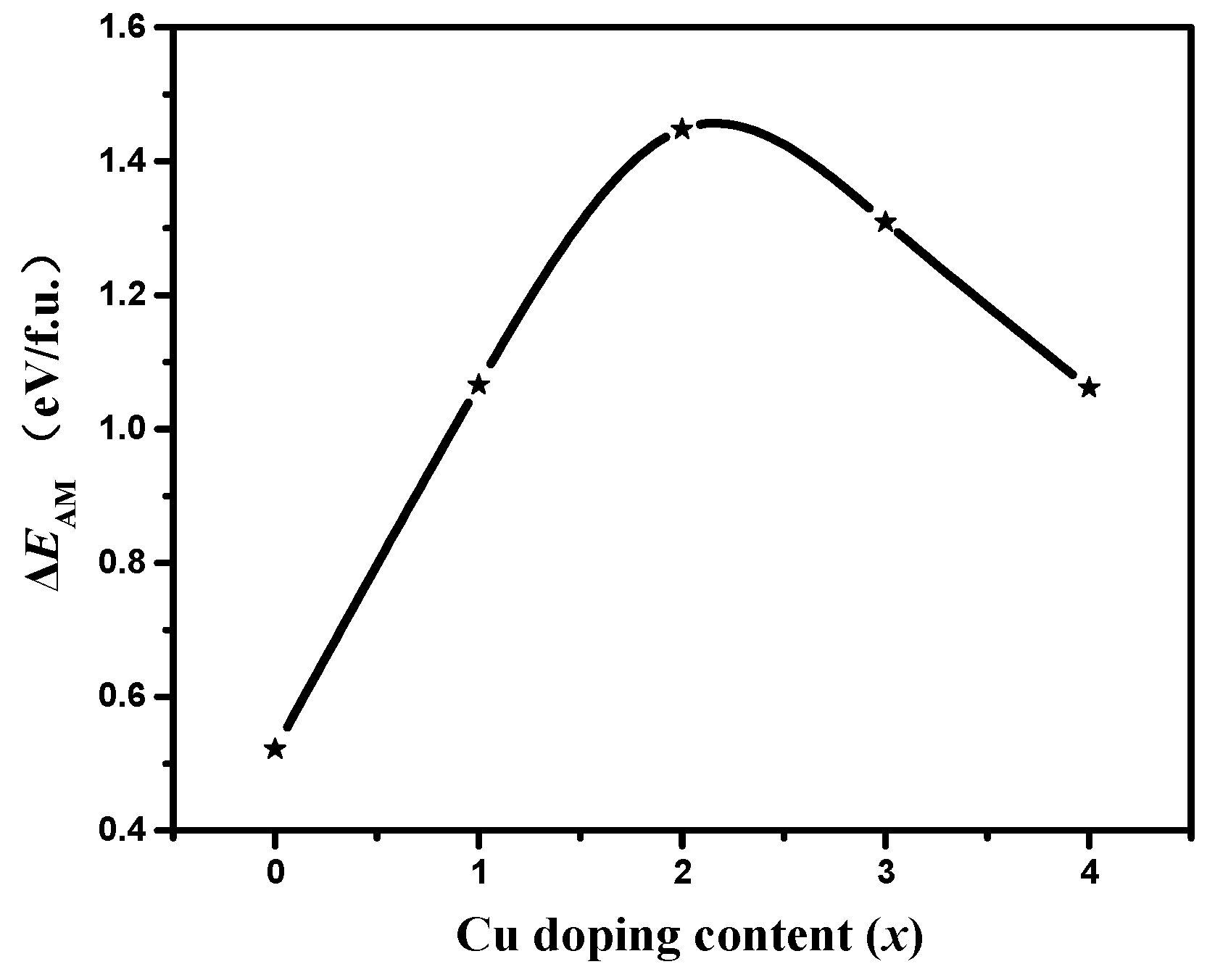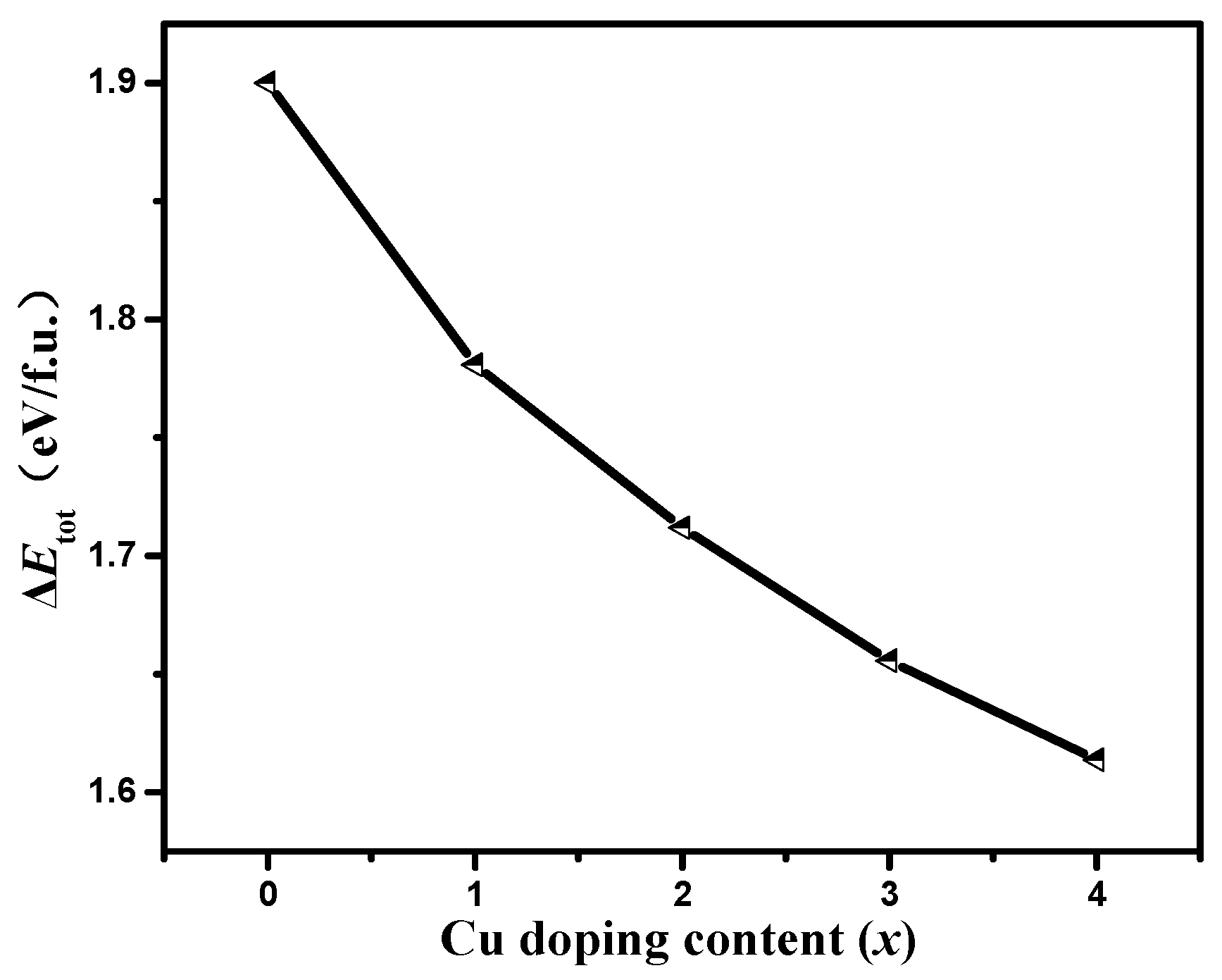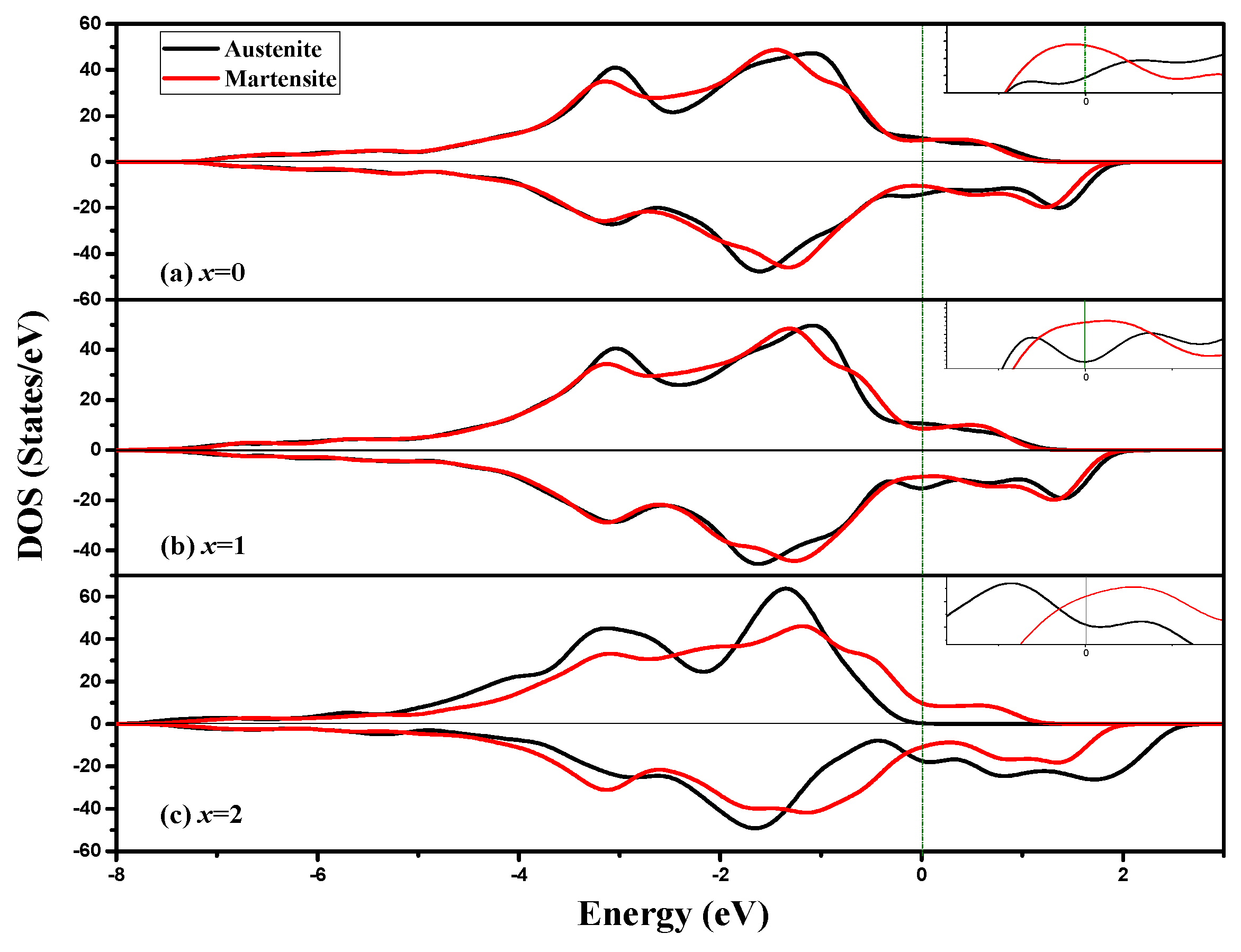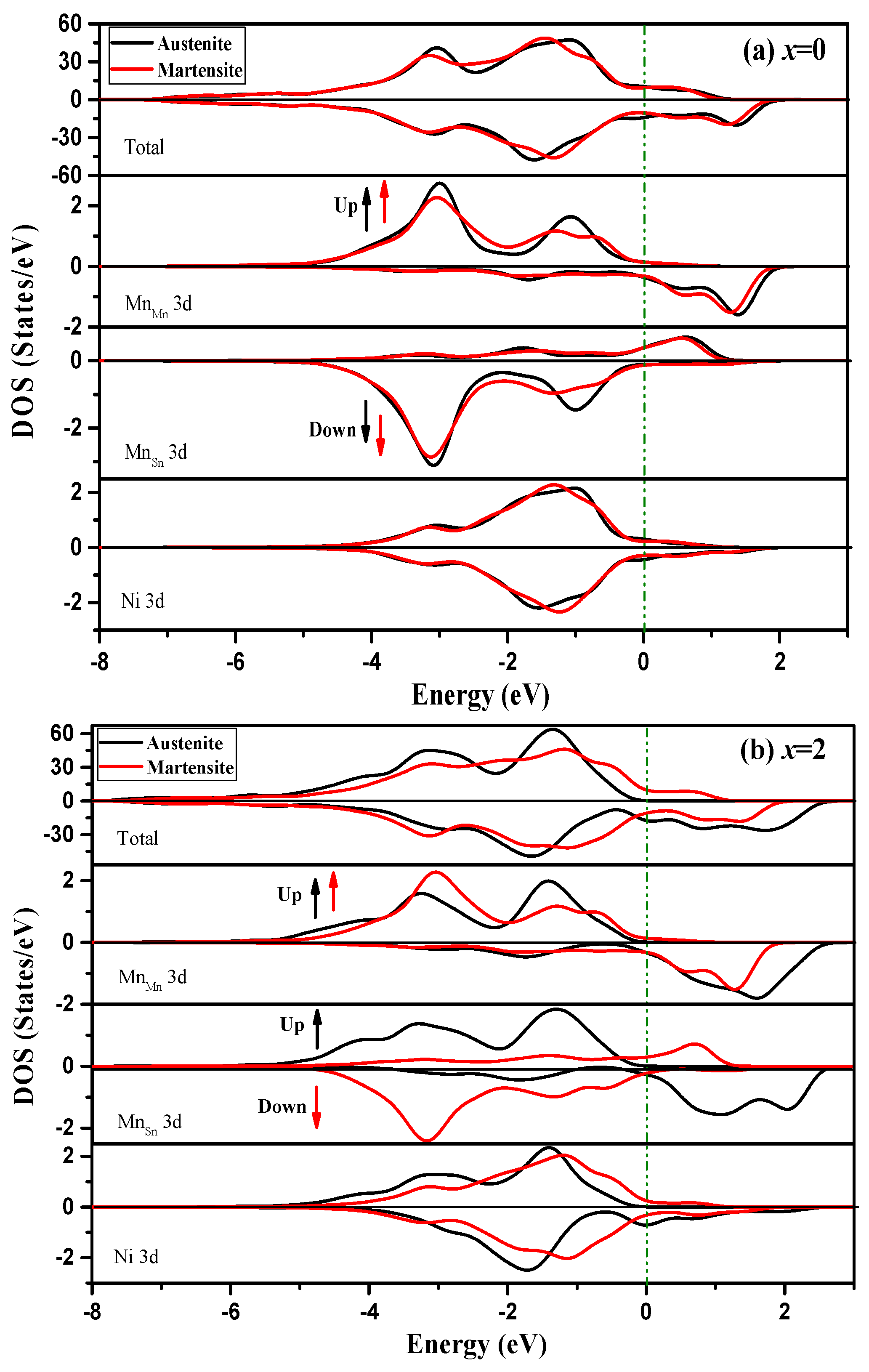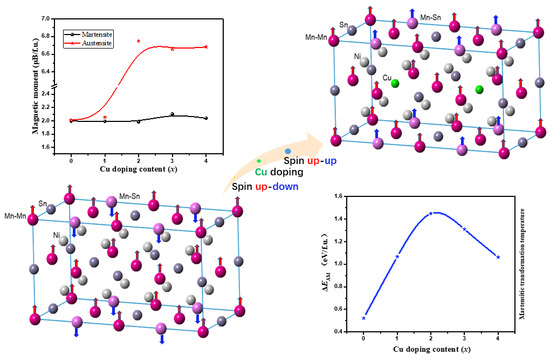1. Introduction
Owing to the coupling of structure and magnetism, the ferromagnetic shape memory alloys (FSMAs) have attracted considerable attention [
1,
2,
3,
4,
5,
6]. The magnetic shape memory arises from a magnetic-field-induced rearrangement of martensite variants in Ni-Mn-Ga [
7]. Based on this mechanism, because the driving force is limited by the anisotropy energy, the output stress induced by the external magnetic field is restricted [
3]. Different from Ni-Mn-Ga FSMAs, Ni-Mn-
X (
X = In, Sn, and Sb) FSMAs can obtain larger output stress resulting from the magnetic-field-induced transformation [
8]. The shift of the reverse martensitic transformation temperature induced by magnetic field, Δ
T, is given by the Clausius–Clapeyron equation:
where
B is the applied magnetic field, and Δ
M and Δ
S are the differences in magnetization and entropy between parent and martensite phase, respectively. Recently, the Mn-rich Ni-Mn-Sn FSMAs have stood out due to their remarkable properties such as giant caloric effects [
9] and complex magnetic behavior with easily-tunable transformation characteristics by a variation of the composition and doping [
7,
8,
9,
10,
11,
12,
13,
14]. Most of these fascinating properties are related to the magnetic-field-induced reverse transformation (MFIRT). Unfortunately, practical applications of these alloys are restricted because of the drawback which is the requirement for a high magnetic field. As Equation (1) shows, to use MFIRT, a larger Δ
M is urgently required for the martensitic transformation. Up to now, some efforts have been devoted to enlarge Δ
M in Ni-Mn-based FSMAs, such as tuning the stoichiometric, substituting foreign atoms, and applying external pressure [
15,
16,
17,
18,
19]. Among these, substituting a small amount of Co/Fe for Ni is an efficient method to enhance the Δ
M. This is mainly due to the local ferromagnetic structure achieved in the antiferromagnetic matrix and the magnetization of the high temperature phase which was effectively enhanced [
20]. The disadvantage of Co doping is that it makes martensitic transformation (MT) temperature too low, even below room temperature. However, the working temperature of Ni-Mn-Sn FSMAs is usually at room temperature or at higher temperatures. Thus, developing the Ni-Mn-Sn FSMAs with a large Δ
M and high MT temperature is essential.
In Ni-Mn-Sn FSMAs, a fourth element addition normally seeks to enhance the magnetic properties, although it can also modify the structure. Cu, for instance, has been shown to have an important effect on the properties of Ni-Mn-Sn compounds. Castillo-Villa et al. have reported improved refrigeration capacity in Ni-Mn-Sn-Cu polycrystalline through the magnetocaloric and elastocaloric combination [
21]. Lately, Li et al. shows that Ni
44Mn
41Sn
11Cu
4 exhibits a giant adiabatic cooling of −8 K at small transformation strains of 1.3%. Ni-Mn-Sn-Cu alloys are proposed as a candidate for the elastocaloric materials [
22]. As for the martensitic transformation, Wang et al. reported that Mn substitution by Cu increased the martensitic transformation (MT) temperature as well as the magnetocaloric effect [
23], while other researchers found that the replacement of Ni by Cu atoms can generate an obvious martensitic transformation temperature change to a lower temperature [
24]. So far, numerous works have focused on adjusting the transformation temperatures or improving the magnetic properties. However, research has rarely been carried out to improve the Δ
M and MT temperature at the same time. Thus, we expect that doping proper Cu in the Ni-Mn-Sn FSMAs can simultaneously enhance the Δ
M and improve MT temperature.
However, due to the restrictions of a long experimental period, limited scope, and high costs, experimental studies have limitations when designing a new material. Before the experiment, calculation by the first principle plays an important role in predicting new ferromagnetic shape memory alloys. The theoretical calculation can simulate substitution or addition elements with any desired composition and accordingly select the most promising one, which can provide useful guidance for experiments. Up to this day, first-principle calculations have been successfully used to calculate the electronic structure, formation energy and magnetic structure of the off-stoichiometric Ni–Mn based FSMAs. Meanwhile, the calculated results are consistent with the experimental results. Thus, by first-principle calculation, we expect to design a new FSMAs material with excellent performance through Cu doping.
In the present paper, the electronic structure and magnetic properties of Ni16Mn12Sn4−xCux alloys (x = 0, 1, 2, 3, and 4) have been calculated by the first principle. The influence of Cu doping on phase transformation temperature, Curie temperature and magnetic structure was clarified. This work can help to understand the phase transformation deeply and design new Ni-Mn-Sn alloys with excellent properties by doping another element. Calculated results showed that the substitution of Cu for Sn is effective not only in enhancing the MFIRMT, but also in increasing martensitic transformation. The results provide the theoretical data and the direction for developing high temperature magnetic-field-induced shape memory alloy in the Ni-Mn-Sn Heusler alloy system.
3. Results and Discussion
To determine the magnetic ground and theoretical lattice parameter of Ni
16Mn
12Sn
4−xCu
x alloys (
x = 0, 1, 2, 3, and 4) in the austenitic phase, we performed total energy calculations with spin polarization. We considered two situations where the magnetic moments of the excess to the Mn atoms in the Sn sites (denoted as Mn
Sn) are parallel or anti-parallel to the Mn atoms in the Mn sub-lattice site (denoted as Mn
Mn). The parallel and antiparallel Mn
Sn-Mn
Mn magnetic interactions are denoted as P and AP states, respectively. Results for the lattice constants of the Ni
16Mn
12Sn
4−xCu
x (
x = 0, 1, 2, 3, and 4) cubic phases for both the AP and P states are plotted in
Figure 2. The calculated energies of the equilibrium lattice constants are −29,898.73 eV and −29,898.80 eV for the AP and P states for
x = 0, respectively. For
x = 1, these total energies are −31,280.29 eV and −31,280.41 eV for the AP and P states, respectively. In both structures, the AP states are lower on the energy scale and are thus significantly more stable than the P states around the equilibrium lattice parameter for the case of
x = 0 and 1. This indicates that the magnetic moment of the Mn
Sn in Ni
16Mn
12Sn
4−xCu
x alloys (
x = 0, and 1) cubic phase is anti-ferromagnetically coupled to the magnetic moment of Mn
Mn. On the contrary, as for the case of
x = 2, the P states are slightly lower on the energy scale than the AP states with nearly the same energy corresponding to the ground state lattice constant of ~6.0 Å. With the further increasing of Cu content, it is worth noting that, in contrast to the alloys without Cu doping, the P state of alloys is evidently more stable than the AP state at equilibrium lattice constant. This result obviously indicates that substitution of proper Cu for Sn converts antiferromagnetic austenite to ferromagnetic state in the cubic austenite phase, and hence increases the magnetization of austenite. Meanwhile, it can be seen that the equilibrium lattice constants of Ni
16Mn
12Sn
4−xCu
x alloys (
x = 0, 1, 2, 3, and 4) decrease with increasing Cu content. Probably because the radius of Cu (1.57 Å) is smaller than that of Sn (1.72 Å), the addition of Cu causes the unit-cell volume to shrink.
In order to see the effect of Cu on martensitic transformation in a Cu-doped Ni-Mn-Sn alloy, the total energy as a function of the tetragonal ratio c/a is calculated for both parallel and antiparallel magnetic interactions of Ni
16Mn
12Sn
4−xCu
x alloys (
x = 0, 1, 2, 3 and 4).
Figure 3 shows the total energies of Ni
16Mn
12Sn
4−xCu
x alloys (
x = 0, 2, and 4) with a variation of the tetragonal ratio c/a, because the curves of the other specimens are similar. For the alloy without Cu doping as shown in
Figure 3a, for structures under the P state, Ni
16Mn
12Sn
4 has only one minimum in the
E-c/a curve at c/a = 0.98 and the energy difference between c/a = 1.00 is rather small. However, as to the
E-c/a curve of structure under AP state, the energy is lower compared with the
E-c/a curve of structure under P state. This indicates that the AP state is favored energetically for all c/a ranges, which means that the Mn
Sn-Mn
Mn magnetic interactions in both austenite and martensite are antiparallel. Also, it is found that, when the structure is under AP state, the energy minimum can be observed at c/a = 1.3, which corresponds to the
L1
0 structure of Ni
16Mn
12Sn
4. This result shows that the AP austenite phase is unstable against the tetragonal distortion in Ni
16Mn
12Sn
4. It undergoes the martensitic transformation from AP austenite phase to AP tetragonal martensite. Due to both austenite and martensite being in the AP state, the Δ
M between the two structural phases is small. This directly leads to the weak MFIRMT in Ni
16Mn
12Sn
4 alloy without Cu addition.
The addition of Cu, from the change of the
E-c/a curves, shows that the energy behaviors along the variation of the c/a do not change. However, Cu introduction changes the relative stability of the structure. As shown in
Figure 3b,c, for the case of
x = 2 and 4, we find that the P state is more stable than the AP state only around the equilibrium lattice constant for the austenitic phase, as indicated by the blue rectangle. Here, the AP state becomes energetically favorable when the martensitic phase transition appears, which indicates that a magneto-structural martensitic transition occurs. Thus, a competition between the P and AP states is evidently observed from the
E-c/a curve of Ni
16Mn
12Sn
0Cu
4. In the vicinity of c/a = 1, the structure under P state is more stable than that of AP state. The energy minimum can be reached at c/a = 1 with respect to the
L2
1 structure under P state. With the c/a deviating from 1, the total energy of structure under P state increases. However, for the structure under AP state, the total energy decreases to the value lower than that of P state and reaches the energy minimum at c/a = 1.4, which corresponds to the martensitic phase
L1
0 structure under the AP state. Thus, we find that the martensite
L1
0 structure for each system keeps the AP state, whereas the antiferromagnetic austenite has been tuned to ferromagnetic state by substitution of proper Cu for Sn.
A good deal of previous research has shown the ferromagnetic activation effect of Co or Fe elements. From the above analysis, we found the same function of Cu addition in Ni-Mn-Sn alloy. Furthermore, the concentration dependence of magnetic moment per formula unit for Ni
16Mn
12Sn
4−xCu
x alloys (
x = 0, 1, 2, 3, and 4) is depicted in
Figure 4. In the case of
x = 0 and 1, the magnetization difference between the austenite and the martensite is very small. With the increasing of Cu content, in the case of
x = 2, 3, and 4, the magnetic moment of austenite was significantly enhanced, while the magnetic moment of martensite changed little. Thus, the magnetization difference between the austenite and the martensite is enlarged evidently. This result is consistent with the conclusion of the
E-c/a curves. This should be attributed to a change of magnetic structure of austenite caused by the substitution of proper Cu for Ni, which turns the Mn-Mn interaction from anti-ferromagnetism to ferromagnetism. Such a high magnetization difference provides a strong driving force for magnetic-field-induced transformation. Thus, a large Δ
M can be obtained by Cu addition in the Ni-Mn-Sn alloy system. We finished the first step in designing the new material with a large Δ
M.
As ever, researchers have pointed out that the total energy difference between the austenite
L2
1 structure and the tetragonal martensite
L1
0 structure (Δ
EAM =
EAP(Cub.) −
EAP(Tetra.)) can be used to predict the possible martensitic transformation and to estimate the MT temperature, approximately [
28]. Generally, the larger energy difference implies a higher MT temperature. In order to clarify the effect of Cu element on martensitic transformation, the Δ
EAM (as indicated by the black arrow in
Figure 4) is calculated.
Figure 5 shows the Δ
EAM per formula unit for Ni
16Mn
12Sn
4−xCu
x alloys (
x = 0, 1, 2, 3, and 4). Firstly, we can see that Δ
EAM increases markedly with a little amount of Cu doping. In the case of
x = 2, the Δ
EAM increases to the maximum. As
x further increases to 3 and 4, the Δ
EAM gradually decreases, which is also higher than that of alloy without Cu addition. Thus, due to a larger Δ
EAM corresponds to a higher TM temperature, the results show that the TM temperature first increases and then decreases with the increasing of Cu content. Proper substitution of Cu for Sn can increase the MT temperature. Now, we finished the second step to design a new material with high MT temperature. These results provide origin for the design of high-temperature magnetic shape memory alloys with low magnetic field.
In practice, elevating the Curie temperature (
Tc) while keeping the martensitic transformation temperature high is essential. Since Ni-Mn-Sn-Cu alloys satisfy the Stone condition of ferromagnetism [
29], the
Tc can be taken to be proportional to the total energy difference between the paramagnetic and the ferromagnetic state (Δ
Etot) [
30]. According to the Heisenberg model and the molecular field theory, the link between Δ
Etot and
Tc is given by
where
represents the ratio
M/M0 of the magnetic moment
M at
T ≠ 0 K and the equilibrium magnetic moment
M0 at
T = 0 K. A number of researchers predict the
Tc by using the Equation (2). Though the predicted values have some deviations compared with the experimental values, only from the total energy difference results, we can still draw the conclusion that the
Tc can be taken to be proportional to the Δ
Etot. In order to investigate the effect of Cu introduction on the
Tc, the total energies of both ferromagnetic and paramagnetic cubic phase of Ni
16Mn
12Sn
4−xCu
x alloys (
x = 0, 1, 2, 3, and 4) were calculated. The calculated results show that the total energy of paramagnetic cubic phase is much higher than that of the ferromagnetic one at all the compositions studied, which is consistent with the fact that the paramagnetic cubic is the high-temperature phase.
Figure 6 shows the total energy difference between the paramagnetic austenite and ferromagnetic austenite per formula unit for Ni
16Mn
12Sn
4−xCu
x alloys (
x = 0, 1, 2, 3, and 4). Obviously, it can be seen that the Δ
Etot linearly decreases with the increase of Cu content. This result indicates that
Tc of Ni
16Mn
12Sn
4−xCu
x alloys decreases with the Cu addition. Though we find that Cu doping shift the MT temperature to higher temperature, the
Tc changes in the opposite directions. Magnetic-field-induced martensitic transformation indicates a transformation sequence of ferromagnetic martensite, ferromagnetic austenite and paramagnetic austenite upon heating. The
Tc of austenite is higher than MT temperature is essential to using Magnetic-field-induced martensitic transformation. Therefore, it is necessary to study how to synchronously increase the
Tc and MT temperature in the further studies.
In order to have a further insight into the electronic structure, the magnetic properties, and the martensitic transformation of Ni
16Mn
12Sn
4−xCu
x alloys (
x = 0, 1, and 2), we investigated the total density of states (DOS) for both the austenite (as indicated by the black line in
Figure 7) and martensite phases (as indicated by the red line in
Figure 7). It can be seen from
Figure 7 that, in the down-spin DOS of the austenite phase, there exists a sharp DOS peak at the Fermi level, indicating the bonding character between the atoms in Ni
16Mn
12Sn
4−xCu
x around the Fermi level, and this is apparently responsible for the martensitic transformation. However, the DOS peak at the Fermi level (E
f) almost disappears when the transition of the tetragonal martensite phase to/from the cubic austenite phase takes place, as seen from the inset (expanded the regions near E
f). This behavior suggests that the DOS in the vicinity of the E
f is an important factor that triggers the occurrence of martensitic transformation [
31].
The aforementioned results suggest that Mn-Mn magnetic interaction in the cubic phase of Ni-Mn-Sn alloy has been turned from anti-ferromagnetism to ferromagnetism by the substitution of Cu for Sn. To gain insight into the origin of magnetic properties and magnetostructural transformation in Ni-Mn-Sn-Cu, we have investigated the electronic structure. Also, because the trend of each change in other specimens is similar to the case of
x = 2, here we only choose the case of
x = 0 and 2 for comparison.
Figure 8 illustrates the DOS for the cubic and martensitic phase of Ni
16Mn
12Sn
4−xCu
x alloys (
x = 0, and 2). In the case of
x = 0, Mn 3d state of majority and minority spin are split with respect to the Fermi level. This distribution makes Mn mostly responsible for the magnetization. Moreover, it can be noted that the magnetic moment of Mn
Sn is anti-parallel to that of Mn
Mn (as indicated by the arrow). Ni 3d states have similar distribution in the majority and minority spin, resulting in a rather small magnetization. With Cu addition, the Mn
Mn 3d state is similar to that of before. However, Mn
Sn 3d state is altered. Mn
Sn 3d state of majority spin is mostly below the Fermi level, while that of minority spin is mostly above the Fermi level. Thus, the magnetic moment of Mn
Sn is parallel to that of Mn
Mn, giving rise to the enhancement of the total magnetic moment. This is in agreement with the aforementioned results. This result further clarifies the change of magnetic moment of Ni-Mn-Sn-Cu.

